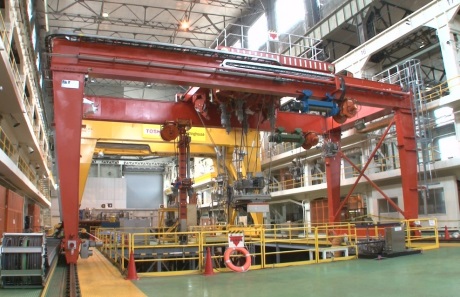A remotely operated system will be supplied by Toshiba for the removal of the remaining debris and fuel assemblies from the used fuel pool of the damaged unit 3 at the Fukushima Daiichi nuclear power plant in Japan. Meanwhile, Nukem Technologies will conduct feasibility studies on the development of further technologies for the plant's decommissioning.
 |
| The fuel removal system (Image: Toshiba) |
The section of the reactor building that sheltered the service floor of unit 3 was wrecked by a hydrogen explosion three days after the tsunami of March 2011 - leaving the fuel pond exposed and covered by debris including machinery and many twisted steel beams.
In early August, plant owner Tokyo Electric Power Company (Tepco) announced that it had removed the 20-tonne fuel handling machine, the largest remaining piece of rubble, from unit 3's used fuel pool at the top of its reactor building. Its removal followed months of preparation and cleared the way for the remaining rubble and the 566 fuel assemblies in the storage pool to be removed.
Toshiba today unveiled at its Yokohama facility a system to carry out this task. The system - developed by PaR Systems - comprises a 74-tonne fuel handling machine - for removal of the debris and fuel - and a 90-tonne crane for bringing in fuel transfer vessels, sealing them and transferring them to the ground-level floor of the reactor building.
The fuel handling machine is equipped with two manipulators - developed by Westinghouse - capable of cutting and grabbing debris, together with a mast and fuel grapple tool for removing fuel assemblies. The manipulator tips, auxiliary hoists and fuel grapple tool attached to the mast can be replaced with an appropriate cutting or gripping jig via remote control, depending on the state of the debris in the pool.
The crane section of the system consists of the main hoist with the transfer vessel lifting rig and an auxiliary hoist for removing and securing the transfer vessel primary lid.
The fuel removed from unit 3 will be transported to the site's nearby communal fuel storage pool, although it will need to be inspected and flushed clean of dust and debris.
Testing of the system and training of operators was carried out up to last December, Toshiba said. Installation of the system at Fukushima Daiichi 3 will now get underway. The removal of debris and fuel using the system is scheduled to begin in fiscal 2017, Toshiba said.
Tepco plans to install a protective cover over the unit to protect it from the weather and prevent any release of radioactive particles during subsequent decommissioning work.
Contract for Nukem Technologies
Mitsubishi Heavy Industries (MHI) of Japan has awarded a contract to Germany's Nukem Technologies for four feasibility studies related to developing technologies for the decommissioning of the damaged Fukushima Daiichi reactors. MHI will be a major contractor for carrying out this work.
Under the contract, Nukem Technologies will carry out studies on the scanning and removal of materials within the units' primary containment vessels, as well as cutting and dismantling the biological shielding walls. The other studies will cover the remote installation of a rail system and a remotely operated fuel debris transportation system.
These studies are to be completed within seven months, after which Nukem Technologies could play a role in carrying out the decommissioning work, the company said in a 15 January statement.
Researched and written
by World Nuclear News




_47120.jpg)

_23621.jpg)






